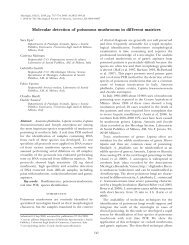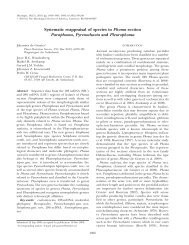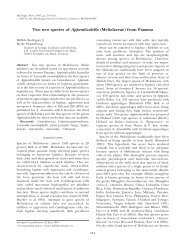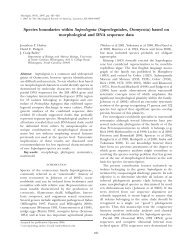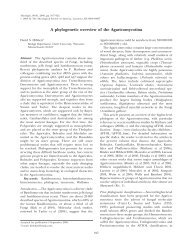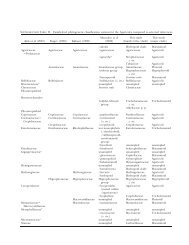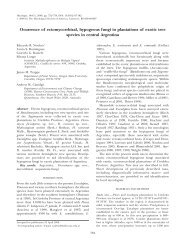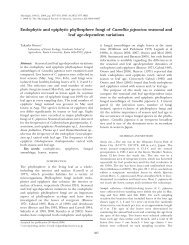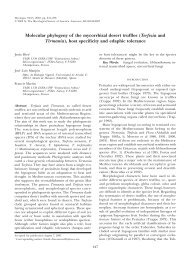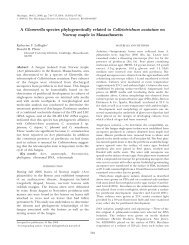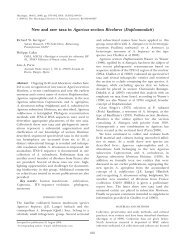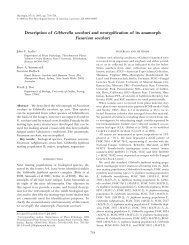Short title: Revision of Morchella taxonomy Taxonomic ... - Mycologia
Short title: Revision of Morchella taxonomy Taxonomic ... - Mycologia
Short title: Revision of Morchella taxonomy Taxonomic ... - Mycologia
Create successful ePaper yourself
Turn your PDF publications into a flip-book with our unique Google optimized e-Paper software.
pubescent. Ascospores 18–25 × 10–16(–22) μm; elliptical; smooth; contents homogeneous. Asci<br />
200–325 × 5–25 μm; eight-spored; cylindrical; hyaline. Paraphyses 175–300 × 2–15 μm;<br />
cylindrical with rounded, subacute, subclavate or subfusoid apices; septate; hyaline in KOH<br />
(2%). Elements on sterile ridges 50–180 × 5–25 μm; septate; terminal cell cylindrical with a<br />
rounded apex, subfusoid, subcapitate or block-like; with brown to brownish contents in KOH<br />
(2%).<br />
Ecology. Appearing at 1000–1500 m in lightly to moderately burned conifer forests,<br />
including forests dominated by Ps. menziesii and P. ponderosa. Found primarily in years<br />
immediately following forest fires but <strong>of</strong>ten appearing in dwindling numbers for several seasons<br />
thereafter; Washington, Idaho, Montana, Wyoming and Yukon Territory; April–July. Specimens<br />
examined (SUPPLEMENTARY TABLE I) were collected in Idaho, Montana, Washington, Wyoming<br />
and Yukon Territory.<br />
Comments. <strong>Morchella</strong> sextelata corresponds to phylogenetic species Mel-6 in O'Donnell<br />
et al. (2011). From a strictly morphological perspective the species is virtually identical to<br />
several members <strong>of</strong> the M. elata Clade (M. septimelata, M. brunnea, M. angusticeps, M.<br />
septentrionalis), but because it apparently is limited to conifer burn sites in western North<br />
America it can be easily separated from all but M. septimelata, from which it is morphologically<br />
and ecologically indistinguishable on the basis <strong>of</strong> currently available data. Elements on sterile<br />
ridges in the latter species were primarily subclavate to clavate in the specimens examined, while<br />
elements in M. sextelata were cylindrical with a rounded apex, subfusoid, subcapitate or block-<br />
like, but this distinction is too tentative and based on too few specimens examined for us to<br />
express confidence that the difference is consistent. Because several <strong>of</strong> the collections studied for<br />
the present work (F 07130403, F 07070405) had pinkish pits, M. sextelata probably was included



